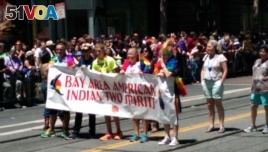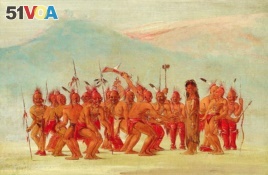24 June, 2018
As a child, Timothy "Twix" Ward, thought he was "normal." But his family saw something "special" about him.
Ward is a member of the San Carlos Apache Tribe in the southwestern state, Arizona.
"It wasn't until I got older that I knew who I was, that I was different from everyone else," Ward said. Ward identifies not as a man or a woman, but both — and neither: Twix Ward is a two-spirit.
The term was first used in Winnipeg, Canada, during a 1990 inter-tribal conference of Native American/First Nations gays and lesbians. Taken from the Ojibwe language, the term was chosen to serve for all Native Americans people who do not fit into traditional gender roles.
"Two-spirited people are not LGBTQ [Lesbian, Gay, Bisexual, Transgendered or Gender Queer], although some two-spirited people are LGBTQ," said Ward. Ward added that a real two-spirit is someone who understands Native American culture and traditions.
Ward lives year-round in a traditional Apache house and takes part in traditional ceremonies. Ward also makes traditional clothing for ceremonies marking the change from girlhood to womanhood.
"I try to teach the girls what the dress is for, the meaning behind it in their ceremony," Ward said.
Not everyone in the community accepts Ward, and the two-spirit admits to loneliness.
"Some people that claim to be traditional are upset with me because they think I'm acting like I know more than them," Ward said. Ward wears the traditional clothing and face paint markings that identify two-spirits.

San Francisco, California's, two-spirit group marches in the city's 2014 Pride parade.
Balancing the male and female
In South Dakota, 2000 kilometers away, Kellie Bingen identifies as a two-spirit bisexual. Born on the Lower Brule Reservation, she now lives in the city of Sioux Falls.
"Two-spirits are people who can balance both their male and their female sides," she said. "Dad taught us girls to do anything that a man can do." But she said she still has a "girl" side. "I can wear a dress, put makeup on, and go out."
Like Ward, Bingen believes only Natives who understand their traditions can claim two-spirit identity. The two-spirit does not believe the term should ever be used to describe non-Natives.
New York City musician and activist Tony Enos presents a different understanding of "two-spirit."
Enos was raised in a racially mixed family in Pennsylvania. He identifies as two-spirit because of his father's Cherokee ancestors.
"Before colonization, we were balance-keepers. We were the only ones that could move between the men's and women's camps. There was a special role for... this blessing to be able to see life through male and female eyes."
And that's what the two-spirit movement is all about, he said: reclaiming the special position two-spirits held in pre-colonial tribal communities.
But is that even possible?
Not always honored
Much of what is known about historic two-spirits comes from books written by Western missionaries and ethnographers. Those writers called two-spirits by the insulting word "berdache," an Arabic word for slave boys.

George Catlin (1796-1872), Dance to the Berdache. Drawn while on the Great Plains, among the Sac and Fox Indians, the sketch depicts a ceremonial dance to celebrate the two-spirit person.
In some tribes, two-spirits were honored as healers, seers and name-givers. Twin-spirits of the Yokuts and Mono peoples of California were diggers of burial places. They were believed to be guided by the dead.
"But not all tribes honored them," said Wesley K. Thomas, a Navajo anthropologist. He believes two-spirits were honored only in tribes like the Navajo, where family history is followed from the mother's line.
In tribes that followed the father's line, they were often simply left alone, but in others, they were killed as soon as their two-spirit nature became clear, Thomas explained.
European colonization, however, meant the end of the two-spirits as Christianity was introduced. Spanish missionary Francisco Palou, who worked in California, wrote in 1777 that all two-spirits should be killed.
By the mid-20th century, gay Native Americans began to go to large cities when they were not accepted by their tribes. But in the cities, Thomas explained, they were often not accepted by the non-Native LGBTQ communities.
Thomas is not critical of the two-spirit movement, which he says "gives them a sense of belonging, of identity."
However, Thomas does not believe they will ever see again the honor they were given in the past.
"It's not possible," he said. "We have been distanced too much from our traditional ways and cultures."
I'm Susan Shand. And I'm Dorothy Gundy.
Cecily Hillary reported this story for VOA. Susan Shand adapted it for Learning English. Catherine Weaver was the editor
Write to us in the Comments Section or on 51VOA.COM.
_______________________________________________________________
Words in This Story
gay – adj. a man who has sex with other men
lesbian – n. a woman who has sex with other women
gender – n. the male, female or other that one identifies with
dress – n.clothing worn by women
missionary – n. one who travels to spreadChristianity
ethnographer – n. one who studies other races and cultures